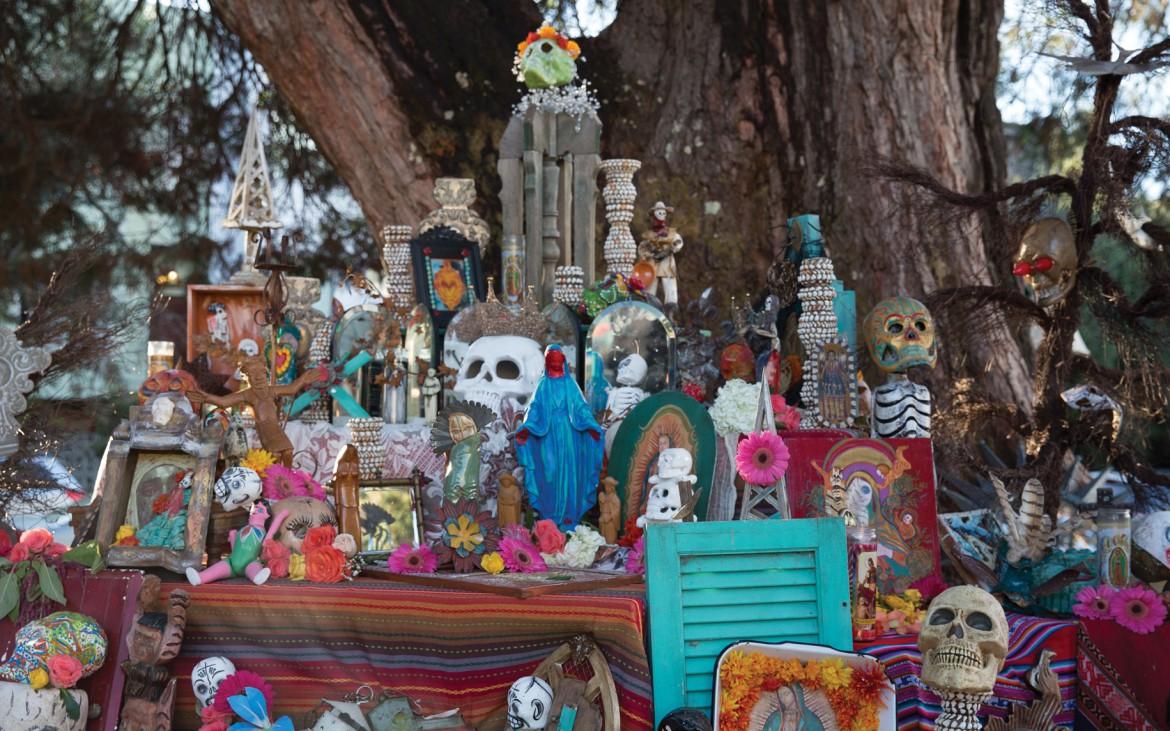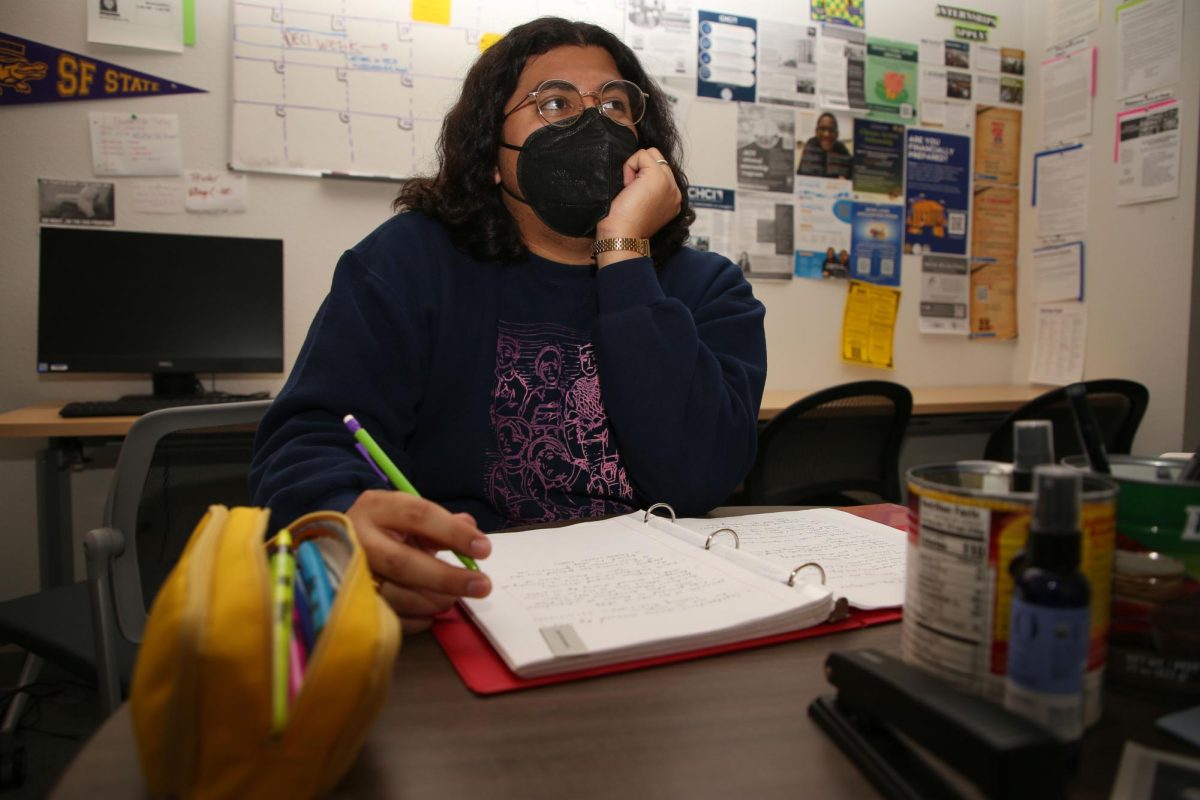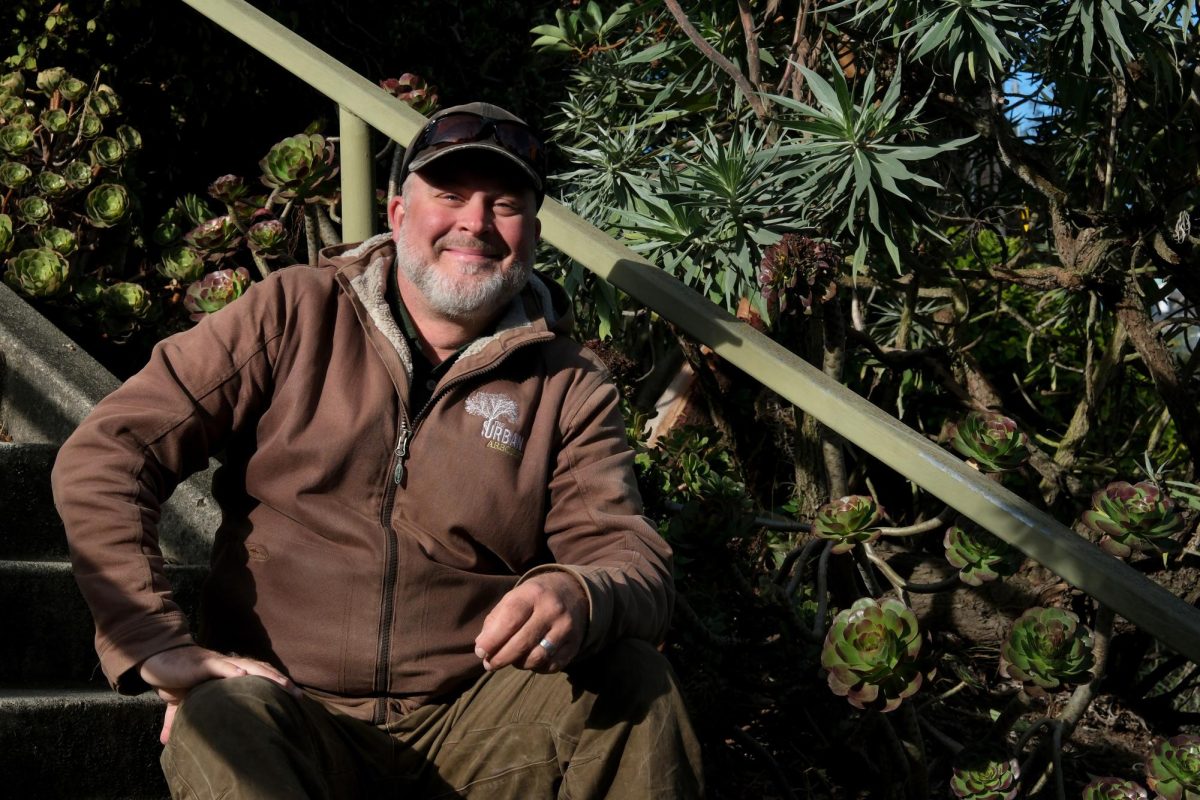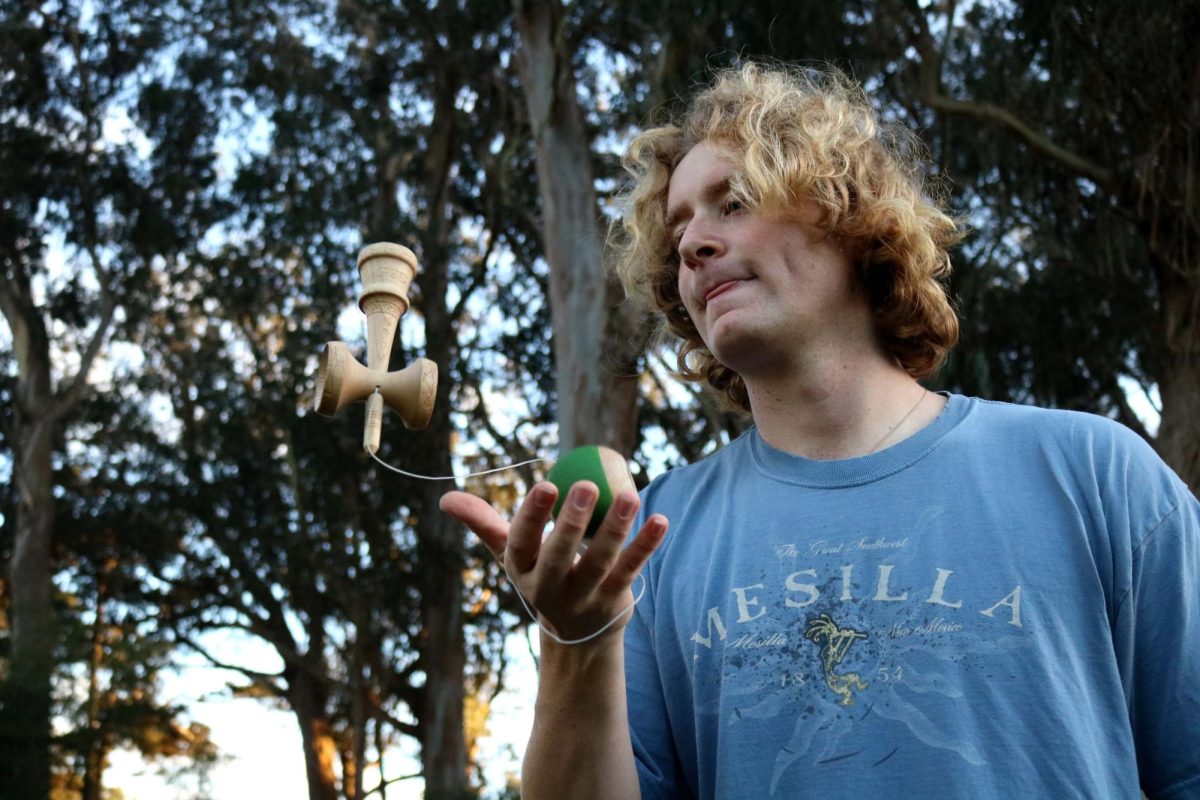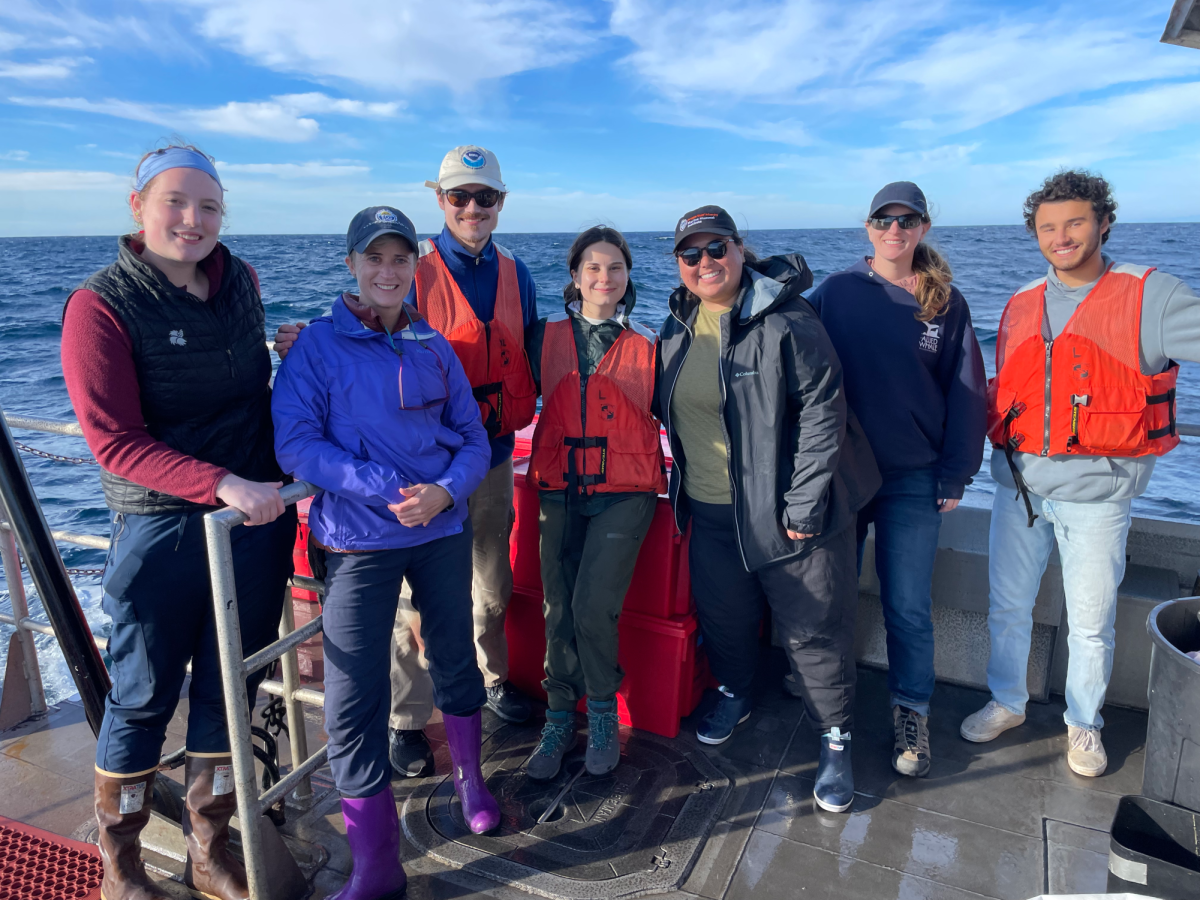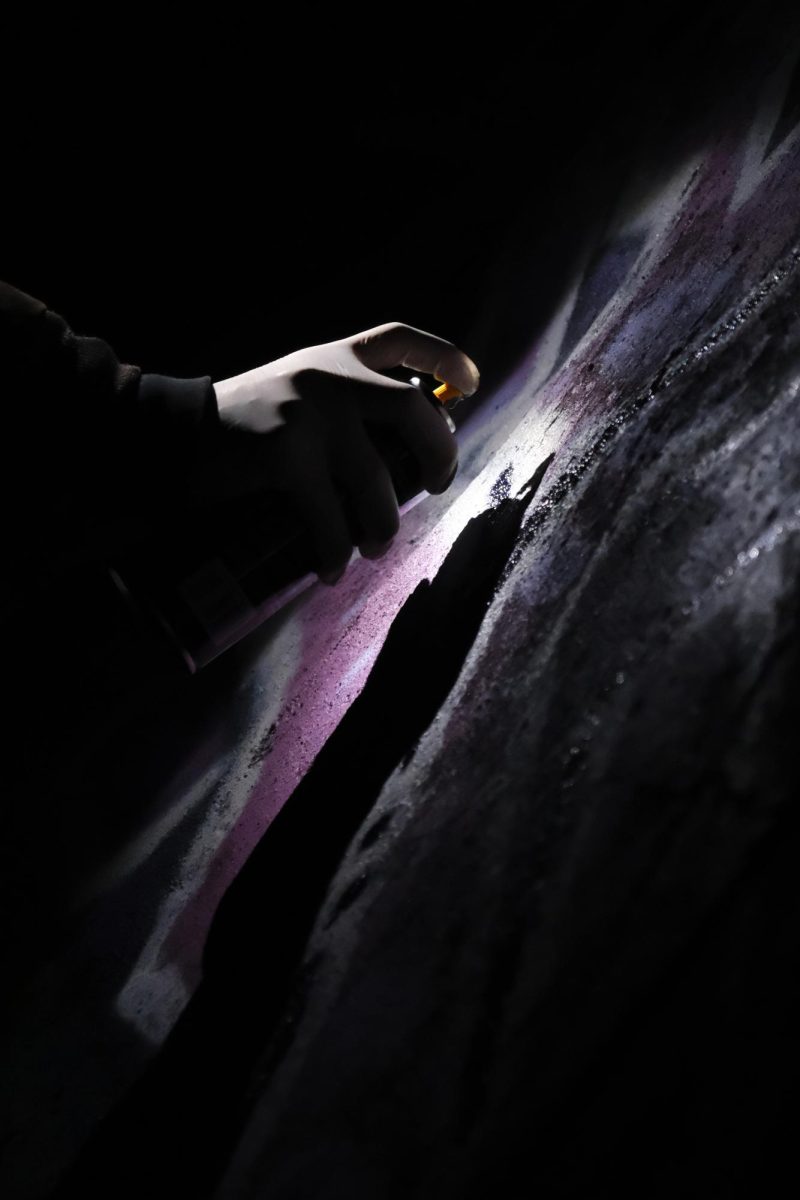An altar by Mary Ann Statler, 65, of San Louis Obispo at the Dia de los Muertos Festival of Altars in Garfield Square Nov. 2. Photos by Brian Churchwell
By Naomi Outlaw
Aztec dancers covered in jingling beaded skirts scooped and twirled in unison to beating drums as they led hundreds of people down blockaded streets in the Mission District. The sun was already set, but black and white faces painted to resemble skeletons still came into focus as the Día De Los Muertos procession moved down 24th Street and burned incense to honor the dead.
Día De Los Muertos is a Latino holiday that celebrates mortality and the natural cycle of life. Traditionally, Indios, the indigenous people of Mexico, celebrated the holiday by creating altars that offered food, candles, art and flowers to the deceased, generally in their homes and in cemeteries. In San Francisco, the holiday includes an annual parade and public altar making. The celebration largely revolves around community art without much focus on traditional elements. This all-inclusive atmosphere dates back to the 1970s when the Chicano movement established the holiday as a way for San Francisco to involve itself in its Latino community. Many who participate in San Francisco, find a space to create art but lack the culture and knowledge about the event’s heritage. While Latino culture is still prominent in the Mission District, some believe the all-inclusive air of this event is wiping away cultural heritage.
Susan Cervantes, the Founding Director of Precita Eyes Mural Arts, said the holiday feels more like a second Halloween in San Francisco. She points to the lack of traditional aspects versus the abundance of modern issues presented in the parade.
“It does feel less traditional,” Cervantes said. “Gentrification, immigration, police brutality; this community takes issues with these so they are brought to the celebration.”
Signs against evictions and Prop I were held high during the procession and some altars included anti-gun, anti-genital mutilation and anti-war themes. While some people mourn the tradition, many of the artists involved in the celebrations feel that they bring fresh perspective to a universal day of reflection.
“Día De Los Muertos used to have more of a sense of appropriation, but I think the artist culture and Latino cultures have come together more,” said Jim Haber, a 30-year resident of the Mission District. “It’s like cross pollination.”
One of those artists “cross pollinating” is Denise Doylle, a mixed media artist who, along with Loralai Lamberson, created an altar commissioned by the Marigold Project.
“It’s about multicultural unification with fears and how we transform them into something, anything, while paying homage and remembrance to ancestors,” Doylle said.
Called The Love Labyrinth, the altar guided guests through a maze where the walls were made of strings of different sizes and colors, some knitted for weeks by Doylle. The Love Labyrinth, created by non-Latino artists, was one of the busiest altars of the night. Although it wasn’t traditional by any means, it was able to communicate the cycle of life into death, a traditional aspect of Día De Los Muertos.
If not lost in the makeup painted on non-Latino faces, then the culture could be lost in non-Latino artists’ altars at the park. These altars tend to be more artistic statements than a symbol of remembrance.
Kiri Moth, the graphic designer commissioned to make the posters for the event by the Marigold Project since 2009, is also not of Latina heritage.
“Originally, I just wanted to be involved in the San Francisco Día de Los Muertos event because it’s a beautiful holiday and I love the symbolism,” Moth said. “But I feel an increasing need to consider how my being included in the creation of the poster could be excluding Latino artists whose perspective on the event is more valuable than mine; perspectives that are perhaps more traditional and more connected to the Latino heritage.
“I wanted to show my kids our culture. I think it’s a lost art.” said April Vigil, who has been building altars at the park for 10 years. Although Mexican, she did not grow up celebrating the holiday and now makes a point to build an altar at home and at the park.
For people like Vigil, Día De Los Muertos not only means something to them because of their experiences, it carries the weight of a cultural identity. Something Doylle, Moth and Haber can sense behind their celebrating and touched upon when they all mentioned the issue of cultural appropriation. In order to not appropriate the tradition they take part of, they make themselves fully aware of the celebration and the associated culture in order to not overstep any boundaries.

“I come from a very European background,” said Sister Hera Sees Candy, a member of The Sisters of Perpetual Indulgence who sponsored an altar at the park. “Participating for me, is in a sense how to honor things other than colonization. I look towards other cultures.”
The altar, dedicated to deceased Sisters, included candles burning with sacred glitter and the ashes of deceased Sisters, a framed list of names of departed Sisters, orange and red paper mache roses, chocolate, whiskey, a mirror and a comb for anyone looking for some comfort. The Sisters have been participating in Día De Los Muertos since the city officially began celebrating it in the 1970s.
As Sister Hera Sees Candy explained, for the Sisters, this is a community event within a community event because many in the transgender community do not have family that would remember and mourn their deaths. Still, she acknowledges there is a line that should not be crossed.
“I try not to appropriate by not claiming anything other than the opportunity to celebrate with my community, but you have to know the history behind the holiday,” Sister Hera Sees Candy said.
Appropriation, such as wearing a traditional American Indian headdress for Halloween or saying “Bye Felicia,” have been a central pieces of discussion. Now Día De Los Muertos in San Francisco is entering the conversation.
“Day of the Dead was brought into the Mission to reestablish an absence of identity for Chicanos,” said Angelica A. Rodriguez, Gallery Coordinator of The Mission Cultural Center. “Artists here and in Mexico have re-appropriated to contextualize culture”.
Additionally, Rodriguez has felt that the Mission District celebration is simply an excuse for people to paint their faces like skulls and dress up. She has seen the commercialization of the traditional holiday with the commercial success of sugar skulls, but, through her gallery at the Mission Cultural Center, explores understanding how people remember the dead and what type of spaces they are creating to mourn.
Maica Folch, Marigold Project Coordinator for the Public Altars, grew up in Spain and traditionally celebrated the holiday at graveyards with family and others in her community. This year, her altar included a ladder down the side of a tree with lit candles and photos of her deceased loved ones.
She acknowledges that there are a lot more people attending in the most recent years and that the numbers alone have changed the festival. Yet, she insists that Día De Los Muertos means the unification of communities through the same heartbreak. This holiday, since its arrival in San Francisco, has invited all of these differences to its spiritual table.
“It is a community event,” Folch said about her decision to make the altars a public event without official vendors or political agendas. “Everyone is coming together on the same level about death. It is a communal healing process.”


